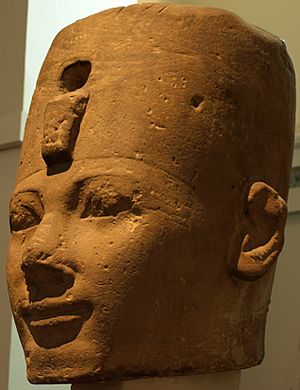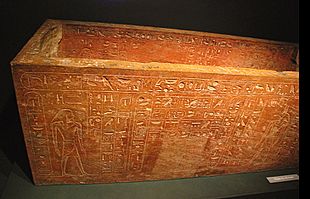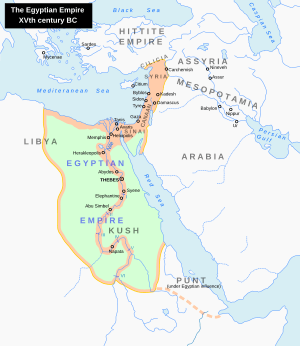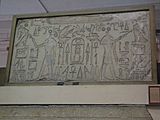Thutmose I facts for kids
Quick facts for kids Thutmose I |
|
|---|---|

A stone head, most likely depicting Thutmose I, at the British Museum
|
|
| Pharaoh | |
| Reign | 1506–1493 BC (disputed) (18th Dynasty) |
| Predecessor | Amenhotep I |
| Successor | Thutmose II |
| Consort | Ahmose, Mutnofret |
| Children | Thutmose II, Hatshepsut, Amenmose, Wadjmose, Nefrubity |
| Father | Unknown (possibly Amenhotep I or Ahmose Sapair) |
| Mother | Senseneb |
| Died | 1493 BC |
| Burial | KV20, later KV38 |
| Monuments | Pylons IV and V, two obelisks, and a hypostyle hall at Karnak |
Thutmose I was an important Pharaoh (king) of Ancient Egypt. He was the third ruler of the 18th Dynasty. His name means "Born of Thoth" (an Egyptian god).
Thutmose I became pharaoh after Amenhotep I died. During his time as king, he made Egypt's borders much larger than ever before. He sent his armies to fight in areas like the Levant (parts of modern-day Middle East) and Nubia (south of Egypt). He also built many temples and a tomb for himself in the Valley of the Kings. He was the first king known to build his tomb there.
He ruled from about 1506 BC to 1493 BC. Some experts believe he ruled from 1526 BC to 1513 BC. This difference depends on where ancient Egyptian sky observations were made.
Contents
Family Life
We don't know for sure who Thutmose I's father was, but it might have been Amenhotep I. His mother, Senseneb, was not from a royal family.
Thutmose I's main wife was Queen Ahmose. She was likely the daughter of Ahmose I and sister of Amenhotep I. However, she was never called a "king's daughter," so some historians think she might have been Thutmose's own sister.
Thutmose I and Queen Ahmose had several children:
- Amenmose: Their first son, who became an army commander but died around the same time as Thutmose I.
- Wadjmose: Another son who died before his father.
- Hatshepsut: A daughter who later became a powerful pharaoh herself.
- Nefrubity: A daughter who died as a baby.
Thutmose I also had a son named Thutmose II with another wife, Mutnofret. Thutmose II later married his half-sister Hatshepsut and became the next pharaoh. Hatshepsut later claimed that her father had chosen both of them to rule together. However, many historians think this was a story she made up to help her claim the throne later on.
When He Ruled
Historians use an ancient sky event to figure out the dates of Thutmose I's rule. During Amenhotep I's reign, Egyptians saw the star Sothis (which we call Sirius) appear in the sky at dawn. This event is called a heliacal rising.
If this sighting happened in the city of Thebes, then Thutmose I would have become king in 1506 BC. But if it happened in other cities like Heliopolis or Memphis, he would have started his rule in 1526 BC.
An Egyptian priest named Manetho, who wrote history in the 3rd century BC, said that Thutmose I ruled for 12 years and 9 months (or 13 years). This information, along with writings from his 8th and 9th years as king, usually leads historians to say he ruled from 1506 BC to 1493 BC. However, some still use the earlier dates of 1526 BC to 1513 BC.
Military Victories
When Thutmose I became king, the region of Nubia (south of Egypt) rebelled. Thutmose I led his army up the Nile River. He personally fought and killed the Nubian king. He returned to Thebes with the Nubian king's body hanging from his ship.
In his third year, he led another trip to Nubia. He ordered a canal at the first cataract (a rocky area in the river) to be made deeper. This made it easier for his ships to travel upstream. This canal was first built by Senusret III of the 12th Dynasty. Making the canal deeper helped Egypt control Nubia.
Here's what an inscription from his time says about this trip:
"Year 3, first month of the third season, day 22, under the majesty of the King of Upper and Lower Egypt, Aakheperre who is given life. His Majesty commanded to dig this canal after he found it stopped up with stones [so that] no [ship sailed upon it];
Year 3, first month of the third season, day 22. His Majesty sailed this canal in victory and in the power of his return from overthrowing the wretched Kush."
In his second year, Thutmose I built a fort near the third cataract. Before this, the Egyptian army usually stopped at the second cataract. A stone slab (called a stele) found there says he had already fought in Syria. His trip to Syria was the farthest north any Egyptian ruler had ever gone. He even set up a stele when he crossed the Euphrates River. The Syrian princes promised to be loyal to Thutmose. But after he left, they stopped sending gifts and started building defenses.
Thutmose I celebrated his victories by hunting elephants in Syria. He returned to Egypt with amazing stories about the Euphrates River, which he called "that inverted water." This was because the Euphrates flowed from north to south, which was the opposite direction of the Nile River (which flows from south to north).
Nubia rebelled again in his fourth year. Thutmose I sent his army even farther south to stop them. He started many projects that helped Egypt control Nubia for the next 500 years. He also appointed a special official called the "King's Son of Cush" (also known as the viceroy of Cush) to live in Nubia. This made it much harder for Nubia to rebel.
Building Projects
Thutmose I started many big building projects, including temples and tombs. His most important work was at the Temple of Karnak, supervised by his architect Ineni.
Before Thutmose I, Karnak was probably a simpler place. Thutmose I made the temple much larger. He added a fifth pylon (a large gateway) and built a wall around the inner temple. He also added two tall flagpoles next to the gateway. Outside of this, he built a fourth pylon and another wall.
Between the fourth and fifth pylons, he built a large hypostyle hall. This was a room with many columns made of cedar wood. These columns were meant to look like a papyrus marsh, which was a symbol of creation in Egypt. He also placed large statues in this hall, showing kings wearing the crowns of Upper and Lower Egypt. Outside the fourth pylon, he added four more flagpoles and two obelisks (tall, thin stone pillars).
Later, Thutmose III replaced the cedar columns with stone ones. Hatshepsut also added two of her own obelisks inside Thutmose I's hypostyle hall.
Thutmose I also built statues at Abydos, and made small additions to buildings in Nubia.
Death and Burial
Thutmose I was the first king known to be buried in the Valley of the Kings. His architect, Ineni, built his tomb and a temple for his funeral. This temple has not been found today.
Thutmose I was buried in a tomb called KV20. His daughter Hatshepsut made the tomb bigger, adding a room for both their stone coffins (called sarcophagi). Later, his grandson, Thutmose III, moved him to a new tomb, KV38.
KV20 was first found during Napoleon's trip to Egypt in 1799. In 1903-1904, Howard Carter (who later found Tutankhamun's tomb) cleared the passages of KV20. He found broken pottery and stone jars. He also found parts of vases made for Queen Ahmose-Nefertari, which were part of Thutmose I's original burial items. Some jars had Thutmose I's name and were also marked by his son, Thutmose II.

Carter also found two sarcophagi in the burial room. Hatshepsut's beautifully carved sarcophagus was empty. The second sarcophagus was for Thutmose I. It was first carved with Hatshepsut's name, but she decided to have a new one made for herself. So, she used the first one for her father, Thutmose I. The stonemasons tried to erase her name and carved Thutmose I's name on it instead.
The sarcophagus is seven feet long and three feet wide. It has words carved on it that show Hatshepsut's love for her father:
...long live the Female Horus...The king of Upper and Lower Egypt, Maatkare, the son of Re, Hatshepsut-Khnemet-Amun! May she live forever! She made it as her monument to her father whom she loved, the Good God, Lord of the Two Lands, Aakheperkare, the son of Re, Thutmosis the justified.
After Hatshepsut died, Thutmose III moved his grandfather to a new tomb, KV38. This tomb had another yellow sarcophagus for Thutmose I. It had writings about Thutmose III's love for his grandfather. KV38 was robbed later, and the sarcophagus lid was broken, and all valuable items were stolen.
Thutmose I's mummy has not been clearly identified. Many pharaohs' mummies were moved to a secret hiding place (called a cache) at Deir el-Bahri in 1881. Among them were mummies believed to be Ahmose I, Amenhotep I, Thutmose II, Thutmose III, and others.
Egyptologist Gaston Maspero thought that an unlabeled mummy, #5283, was Thutmose I. Its face looked similar to the mummies of Thutmose II and Thutmose III. Maspero wrote about this mummy:
The king was already advanced in age at the time of his death, being over fifty years old, to judge by the incisor teeth, which are worn and corroded by the impurities of which the Egyptian bread was full. The body, though small and emaciated, shows evidence of unusual muscular strength; the head is bald, the features are refined, and the mouth still bears an expression characteristic of shrewdness and cunning.
This mummy is in the Egyptian Museum in Cairo. However, in 2007, Dr. Zahi Hawass said that this mummy was actually a 30-year-old man who died from an arrow wound. Because of his young age and cause of death, this mummy could not be King Thutmose I.
Images for kids
See also
 In Spanish: Tutmosis I para niños
In Spanish: Tutmosis I para niños






